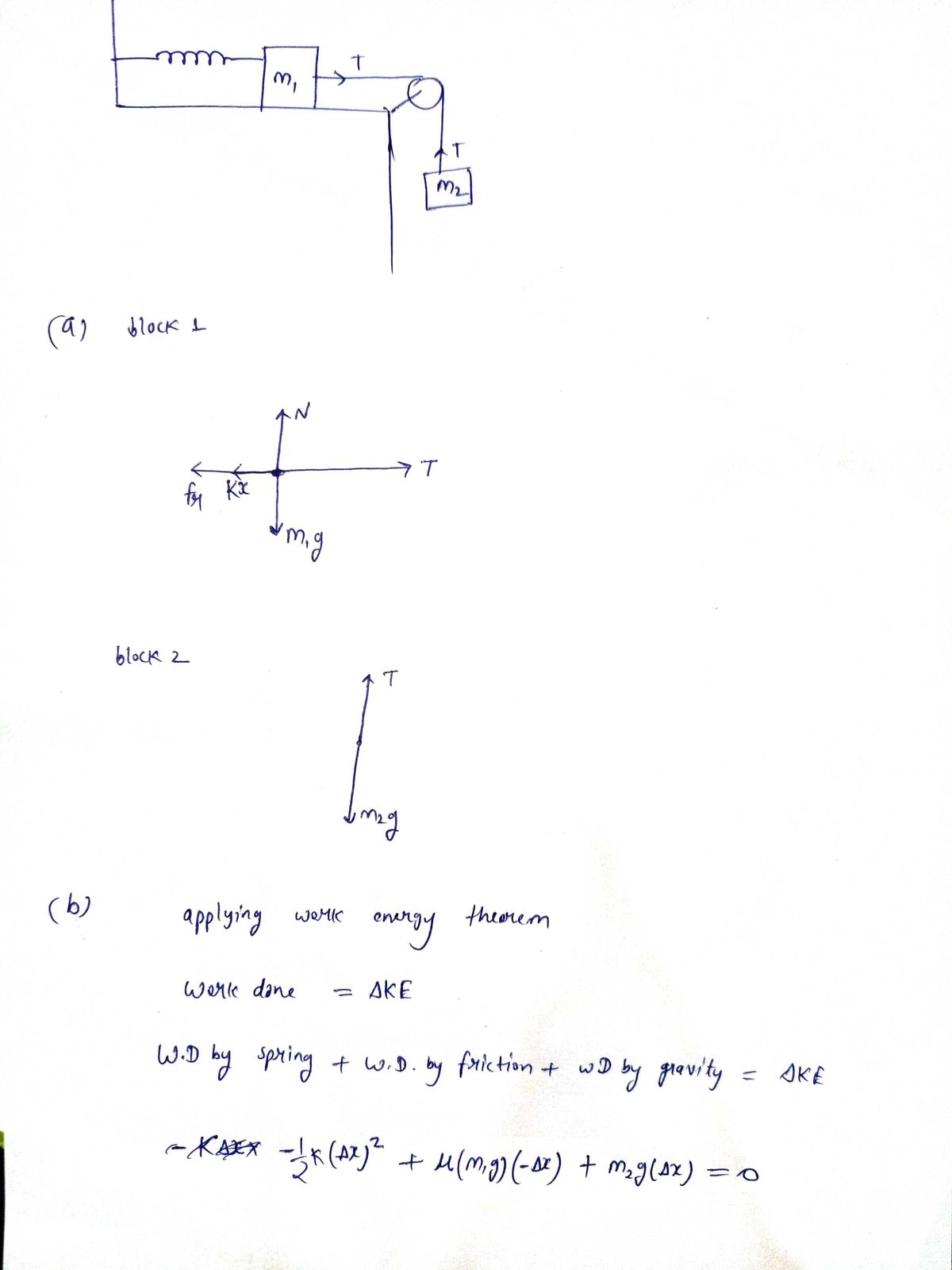1. Consider the setup shown below: a block with mass m; sits on a table with friction coefficient µ between the table and itself, attached on one side to a spring with stiffness k, and on the other side to a cord with negligible mass that wraps over a frictionless pully and supports a second block with mass m2 that's suspended in the air over the edge of the table. The friction between block 1 and the table is not enough to hold up block 2 so that, when it's released from rest, the spring stretches a distance Ax before the system comes to rest.
1. Consider the setup shown below: a block with mass m; sits on a table with friction coefficient µ between the table and itself, attached on one side to a spring with stiffness k, and on the other side to a cord with negligible mass that wraps over a frictionless pully and supports a second block with mass m2 that's suspended in the air over the edge of the table. The friction between block 1 and the table is not enough to hold up block 2 so that, when it's released from rest, the spring stretches a distance Ax before the system comes to rest.
Physics for Scientists and Engineers: Foundations and Connections
1st Edition
ISBN:9781133939146
Author:Katz, Debora M.
Publisher:Katz, Debora M.
Chapter5: Newton's Laws Of Motion
Section: Chapter Questions
Problem 35PQ: A black widow spider hangs motionless from a web that extends vertically from the ceiling above. If...
Related questions
Topic Video
Question

Transcribed Image Text:1. Consider the setup shown below: a block with mass m; sits on a table with friction coefficient u between the table
and itself, attached on one side to a spring with stiffness k, and on the other side to a cord with negligible mass that
wraps over a frictionless pully and supports a second block with mass m2 that's suspended in the air over the edge of
the table. The friction between block 1 and the table is not enough to hold up block 2 so that, when it's released
from rest, the spring stretches a distance Ax before the system comes to rest.
a. Draw and label a free-body diagram for each block. (Use the gridlines to
make sure that the relative lengths of your vector arrows are correct.)
k
m1
block 1:
block 2:
m2
b. What is the kinetic friction coefficient between block 1 and the table?
Expert Solution
Step 1

Trending now
This is a popular solution!
Step by step
Solved in 2 steps with 2 images

Knowledge Booster
Learn more about
Need a deep-dive on the concept behind this application? Look no further. Learn more about this topic, physics and related others by exploring similar questions and additional content below.Recommended textbooks for you

Physics for Scientists and Engineers: Foundations…
Physics
ISBN:
9781133939146
Author:
Katz, Debora M.
Publisher:
Cengage Learning

College Physics
Physics
ISBN:
9781305952300
Author:
Raymond A. Serway, Chris Vuille
Publisher:
Cengage Learning

University Physics Volume 1
Physics
ISBN:
9781938168277
Author:
William Moebs, Samuel J. Ling, Jeff Sanny
Publisher:
OpenStax - Rice University

Physics for Scientists and Engineers: Foundations…
Physics
ISBN:
9781133939146
Author:
Katz, Debora M.
Publisher:
Cengage Learning

College Physics
Physics
ISBN:
9781305952300
Author:
Raymond A. Serway, Chris Vuille
Publisher:
Cengage Learning

University Physics Volume 1
Physics
ISBN:
9781938168277
Author:
William Moebs, Samuel J. Ling, Jeff Sanny
Publisher:
OpenStax - Rice University

An Introduction to Physical Science
Physics
ISBN:
9781305079137
Author:
James Shipman, Jerry D. Wilson, Charles A. Higgins, Omar Torres
Publisher:
Cengage Learning

Principles of Physics: A Calculus-Based Text
Physics
ISBN:
9781133104261
Author:
Raymond A. Serway, John W. Jewett
Publisher:
Cengage Learning

Physics for Scientists and Engineers, Technology …
Physics
ISBN:
9781305116399
Author:
Raymond A. Serway, John W. Jewett
Publisher:
Cengage Learning